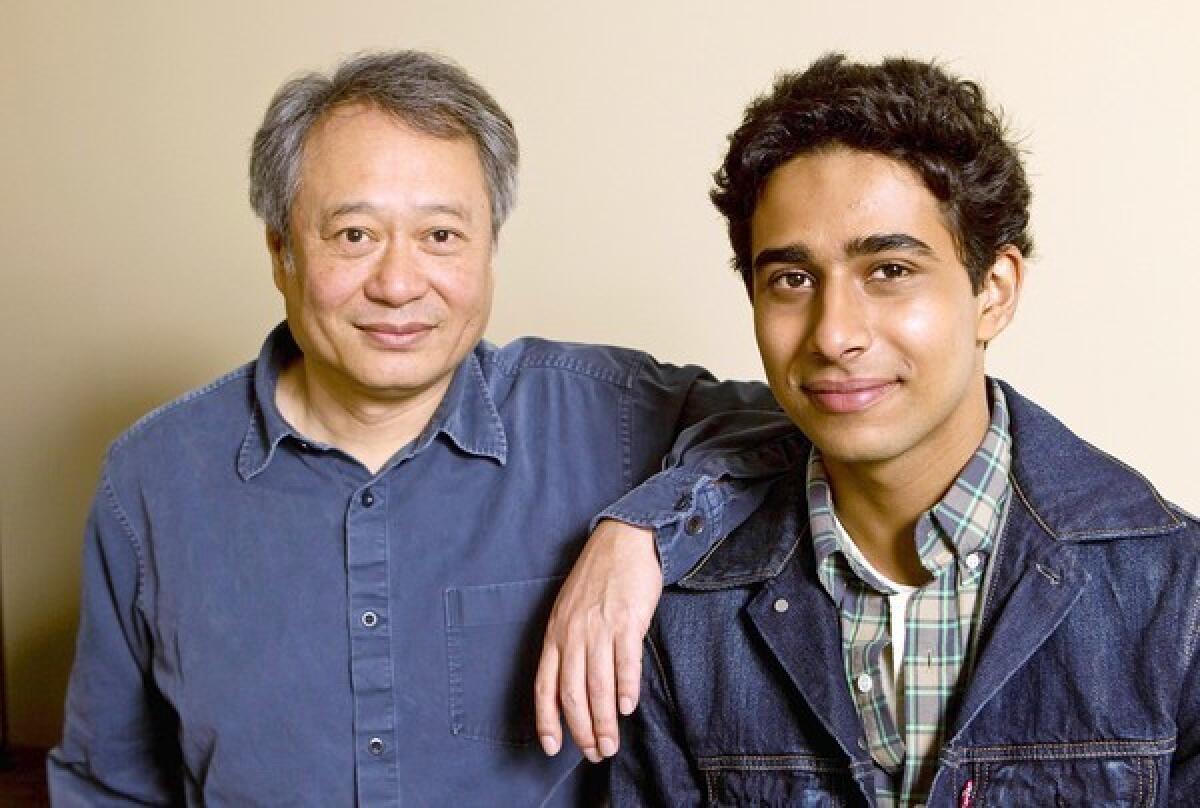Ang Lee, Suraj Sharma became each other’s lifeboat in ‘Pi’

By all accounts, director Ang Lee is the soul of civility on a film set, sure-footed but collaborative, meticulously focused but ready to smile — the patient but quietly demanding center of an adventurous array of films. Lee gives his actors directorial “notes” in muted tones, but precisely and often enough that his longtime editor, Tim Squyres, privy to the tail ends of scenes from each day’s footage, assures him that his actors will sometimes react when Lee turns away: “He’ll see that when I tell an actor something, very often they’ll roll their eyes behind me.”
It’s a characteristically humble confession (or exaggerated self-deprecation?) from the director who won an Oscar for 2005’s “Brokeback Mountain” and was nominated for 2000’s “Crouching Tiger, Hidden Dragon,” but he brings it up only to reinforce just how congenially he worked with neophyte actor Suraj Sharma, then 17, in shooting “Life of Pi.”
It seems Lee had to set Sharma up to suffer a gross indignity from the Bengal tiger named Richard Parker that the teen is trapped with on a lifeboat in a scene halfway through the philosophical adventure saga, as adapted from Yann Martel’s 2001 bestseller, and the young actor wasn’t quite obstreperous enough in the initial takes.
The moment came during a long day’s work in the production’s ocean-simulating “wave tank,” says Lee. “The boat’s rocking, Suraj has lost his voice, he’s yelling at the tiger and I gave him some direction and — it’s the only time he lost it. In the take, he just roars! And that’s the take in the film.”
The youthful native of New Delhi and the seasoned director, who was born in Taiwan but has effectively been a citizen of world cinema since launching the “family” trilogy capped by 1994’s “Eat Drink Man Woman,” clearly have a special artistic and personal relationship. Plucked from an initial heap of 3,000 candidates, Sharma barely hung on through the cuts (“the last every time,” Lee recalls) until the shortlist stood at 12. Then, after an audition in which Sharma had to perform the title character’s mind- (and story-) bending final speech, Lee simply knew: “I could smell it — I think he’s an artist and a spiritual person, deep inside.”
Sharma, now 19, seated alongside Lee on a banquette in a posh West Hollywood hotel restaurant recently, absorbs this thought with the same quiet deference he’s apparently shown since Lee helped convince his parents that he would in effect be the young man’s guru. Using the honorific Chinese name for “director” by which he addresses Lee, Sharma says, “Dao Yan sent us a letter saying, ‘Look, one year on this movie will be more education than even a year in school.’ And that is so true. That letter really helped us go along with the whole thing. Because it was scary.”
BUZZMETER: ‘Life of Pi’s’ Oscar chances
Once Sharma took on the part, Lee’s real work was turning that shared act of faith into useful reality: “If we didn’t have the boy, we didn’t have the movie,” Lee knew, and along with readying him to spend long days in a water tank, Lee handed him homework films ranging from “The Bicycle Thief” to “It’s a Mad, Mad, Mad, Mad World,” and coached him through scenes from Edward Albee and Tennessee Williams.
Sharma, whose Pi character is also represented by younger and older actors as the plot unfolds, was a bit more formidable than his lean frame and spectacles at first suggested; he was a karate student, albeit one who almost quit before getting renewed inspiration from the film “Crouching Tiger,” made by the man he’d meet years later.
Sharma’s workmanlike grit impressed both Lee and the film’s stunt coordinator. Possessed of guts but no braggadocio, he several times risked injury — and a production delay — by performing gags such as flipping with the capsizing boat he shared with a computer-generated tiger: “Working on the boat, you get cut up a lot,” he says matter-of-factly, “but that just helps you realize what it feels like to be on a boat in the first place. So you just use it, I guess.”
Lee credits Sharma’s work ethic with inspiring the entire company. “In demanding things from him, it feeds back to us, and how he carries that reminds us of why we want to make movies. If he’s reliable, everybody else has to perk up. So it’s kind of a life together, and eventually it turns spiritual and emotional, beyond doing a job. It’s something we lived together — like taking a voyage.”
To fulfill a story point, Sharma had to find his own inner tiger, which he did by observing the beasts: “All the muscles flexing, at the same time it’s unbelievable how gracefully they walk — there’s a calculatedness to the way they move.”
In the last stages of shooting, after Pi has spent 227 days at sea with the tiger, Lee forbade his company to speak with Sharma, who by then looked “like a dilapidated saint.” Sharma met him halfway: “Slowly, inside me, I dipped in my mind and just went dark.”
IN CASE YOU MISSED IT: Golden Globe nominations
Lee doesn’t need much prompting to recall, with evident emotion, the intensity of working with Heath Ledger, who died two years after earning an Oscar nomination for “Brokeback Mountain.”
Hearing of Ledger’s death in January 2008 after disembarking from a flight to Japan, says Lee, “I went blank.”
Now, says Lee as Sharma listens, absorbed, “I want to remember the time I worked with Heath as an actor, because when you work with somebody like this” — he inclines his head toward Sharma — “it’s beyond a personal level. During shooting you go through things that I don’t share with my wife or children, where we just zoom right into the core of things. What may seem like torture to others, we actually like. That happens only with good actors. They just need that excuse, just need somebody like me to give them a topic so they can go through that.”
Lee, amused at the thought almost despite himself, glances sidelong at Sharma: “I give actors my best, and they give theirs to me.”
MORE COVERAGE
PHOTOS: Memorable red carpet moments
VIDEO: Go behind the scenes with the awards contenders
More to Read
From the Oscars to the Emmys.
Get the Envelope newsletter for exclusive awards season coverage, behind-the-scenes stories from the Envelope podcast and columnist Glenn Whipp’s must-read analysis.
You may occasionally receive promotional content from the Los Angeles Times.










